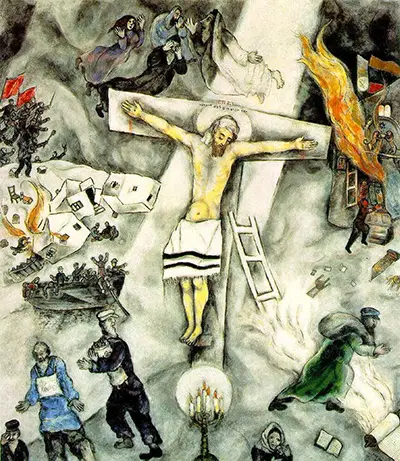The White Crucifixion was Chagall's passionate reaction to the escalating massacres by the National Socialist German Workers' (Nazi) Party culminating in Kristallnacht. In the wake of historical repression and anti-Semitism, as well as in the political and social climate, the artist's early life was spent in Czarist Russia. This is the setting in which the oil on canvas masterpiece was conceived. This canvas has thematic ties to Renaissance religious painting and demonstrates the agony of Jesus and the Jews. Aggressive disputes are presented, accompanied by scenes showing Jewish torture at the hands of the Nazis, including the setting of synagogues on fire. Jesus is depicted, nailed to the cross exalted, martyred, and personified in the middle, at the focal point, of the image as Jewish. The White Crucifixion artwork is a rare blend of Christian and Jewish symbolism.
For the artist Marc Chagall, the 1938 painting marks a crucial, pivotal moment. It was the first of a major collection of paintings featuring the depiction of Christ as a Jewish martyr and profoundly drawing attention to the injustice and misery of the 1930s European Jews. Chagall highlighted the Jewish identity of Jesus in many ways in White Crucifixion, his initial and greatest work on the subject. He substituted Jesus' conventional waistcloth with a prayer shawl. Then replaced his crown of thistles with a headcloth and the weeping angels that typically surround him, substituted with three biblical monarchs and a matriarch, dressed in traditional Jewish clothing.
Chagall depicts the destruction of pogroms on each side of the cross. A settlement is invaded and burnt on the left, causing refugees to leave by boat and the three bearded figures below them to run on foot, one of whom clings to the Torah. On the right side of the cross, a synagogue and its Torah Ark rises in ashes, while a mother soothes her child beneath. Chagall's artwork explicitly compares the Nazis with Christ's torturers by comparing the martyred Jesus with the oppressed Jews and the Crucifixion with current affairs. It warns of the religious repercussions of their acts. As one of the most articulate denunciations of war and hatred within the 20th Century, the original canvas is currently exhibited at the Art Institute of Chicago.
